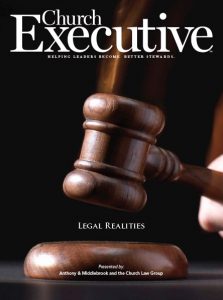
By David O. Middlebrook
There are more than 400,000 churches in the United States, each with its own governance structure and decision-making model.
With so ![]() many different models and terminology used to describe church governance structures — elders, deacons, trustees, directors, pastor and apostle — it can be quite confusing to determine what’s the best and most biblically-sound corporate structure for your own church.
many different models and terminology used to describe church governance structures — elders, deacons, trustees, directors, pastor and apostle — it can be quite confusing to determine what’s the best and most biblically-sound corporate structure for your own church.
As an attorney with more than 25 years of experience representing churches, I’m often asked which structure is the best. The truth is that there are many large and healthy churches that have incredibly diverse governance structures. However, the key to any governance structure is that it’s clearly defined as to who’s in charge.
One major pitfall for church leaders is a lack of understanding around the legal rights of your church’s members. Without understanding exactly what your church members are entitled to do, or to know, church leaders run the risk of creating a problem by not going through the decision-making matrix outlined in the governing documents of the church.

But, not all church members have rights, and not all churches have legal corporate members. In fact, most states give religious nonprofits the ability to choose, at the time of incorporation, whether they will have legal members. If the incorporators choose not to have legal members, then the board of directors, or trustees, will be 100-percent responsible for the organization.
So, what are the options for church governance?
There are three basic models you’ll find in a majority of churches across the United States:
#1: Congregational. In a Congregational Model, the members of the church have the right to vote and make almost every decision regarding the church’s management and operation. There are monthly, (or at least regular) business meetings in which all current members are allowed to attend and vote on various matters. This model is more prevalent in smaller, older churches that don’t have significant business activities or that believe such a model is required by their understanding of scripture.
It’s important to understand that most states generally say that the board of directors has authority over the corporation unless the corporate documents clearly state that the power is specifically designated to the members. Accordingly, if your church wants to follow the congregational model in which members retain the right to vote on all issues, the corporate documents must clearly articulate that fact; otherwise, the typical default rule is that a board will control.
#2: Contemporary. This model allows the senior pastor to lead the daily church affairs with a board of directors having oversight and co-management authority. There are no corporate “members” (there can still be “members” as far as having affiliation to the church, they just might not have corporate voting authority).
This model is based upon the modern view that a church is best served by a vocational staff who are at the church daily and have a better understanding of its needs. This model also imagines that the church’s business activities are too numerous or complex to wait for congregational meetings and/or that the average congregant does not want to be bothered with the church’s business decisions, but only wants to attend as a worshipper.
 #3: Hybrid. Finally, many churches seek to find some balance between the other two structural models and opt for a “hybrid” structure. Under this model, the church is run by the vocational staff who — with oversight from a board of directors — are accountable to members who retain limited voting rights on big issues. This model often reserves big decisions for the members while the board of directors and the staff leadership make the remaining decisions.
#3: Hybrid. Finally, many churches seek to find some balance between the other two structural models and opt for a “hybrid” structure. Under this model, the church is run by the vocational staff who — with oversight from a board of directors — are accountable to members who retain limited voting rights on big issues. This model often reserves big decisions for the members while the board of directors and the staff leadership make the remaining decisions.
For example, under the hybrid model, members may retain the right to vote on issues such as dissolution, the acquisition of debt over a certain amount, or the selection and removal of the senior pastor. This hybrid structure creates a middle ground that allows everyone to be involved and fosters accountability.
Over the past several years, this structure has increased in popularity — particularly for churches that previously followed a congregational structure but determined that the members lacked meaningful participation on all issues. With a desire for accountability, some congregational churches have opted for the hybrid model, forming a board of directors, yet allowing members to maintain limited voting rights on issues of great importance.
Identify who’s in charge
No matter which management model your church chooses, it’s important that the corporate documents clearly identify who’s in charge. Since clearly drafted documents affect basic church operations, it’s important for both the staff and congregation to know who to look to for leadership. If the corporate documents are unclear, the church is exposing itself to many problems.
For example, if the church is seeking a loan, the lending institution can delay or reject financing if it’s unclear who’s in charge of the corporation and who has authority to make decisions. Furthermore, a lack of clarity can lead to trouble if there’s ever a church dispute or split. If the congregation believes it has the right to vote and the leadership thinks the opposite, then who’s in control of the church?
Also, should a church decide to submit a 1023 application for tax-exempt recognition, the IRS will want to know who has the power to make decisions and vote on issues within the church.
Now that you know the different models typical of church governance, go ahead: break out your governing documents and read them, cover to cover. You might be surprised to discover that your church’s operating structure doesn’t align with the governance structure set out in your articles of incorporation or bylaws.
Churches can run into serious issues when they aren’t following their corporate documents, or if their bylaws are in conflict with the church’s articles of incorporation. You might even be surprised to hear that in most cases, if the articles of incorporation contradict the bylaws, state law provides that the articles supersede the bylaws, thus rendering the bylaws ineffective.
Today is a perfect day to review your church’s corporate documents. Remember: Moses didn’t go to the mountain to retrieve these documents; they should be reviewed and updated periodically to make sure the church is operating in a manner consistent with its corporate documents.
The materials in this article are provided for informational purposes only and do not constitute legal advice. This article is intended, but not promised or guaranteed to be current, complete or up-to-date and should in no way be taken as an indication of future results. Transmission of the information in this article is not intended to create — and the receipt does not constitute — an attorney-client relationship between sender and receiver.
David O. Middlebrook is a founding shareholder of Anthony & Middlebrook and the Church Law Group in Grapevine, TX. His clients include high-profile charitable and religious organizations, both domestic and international.


